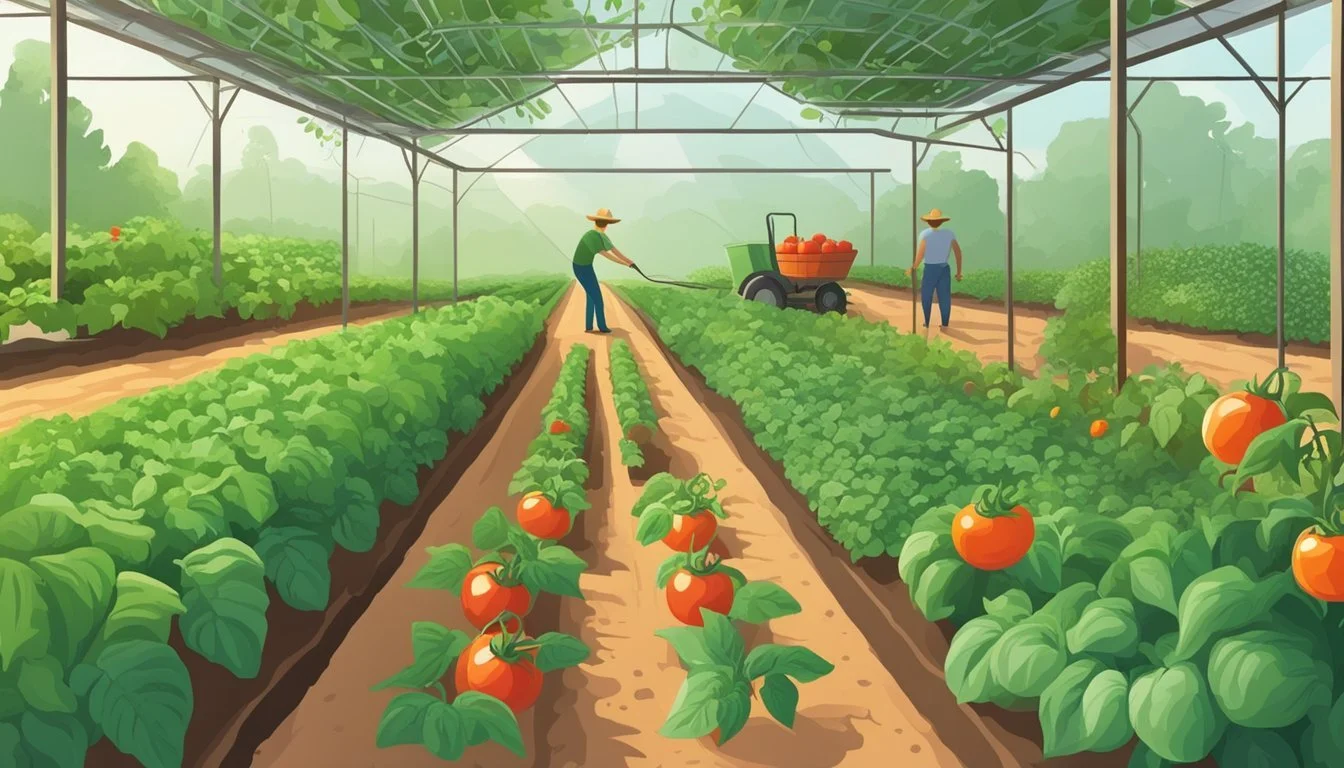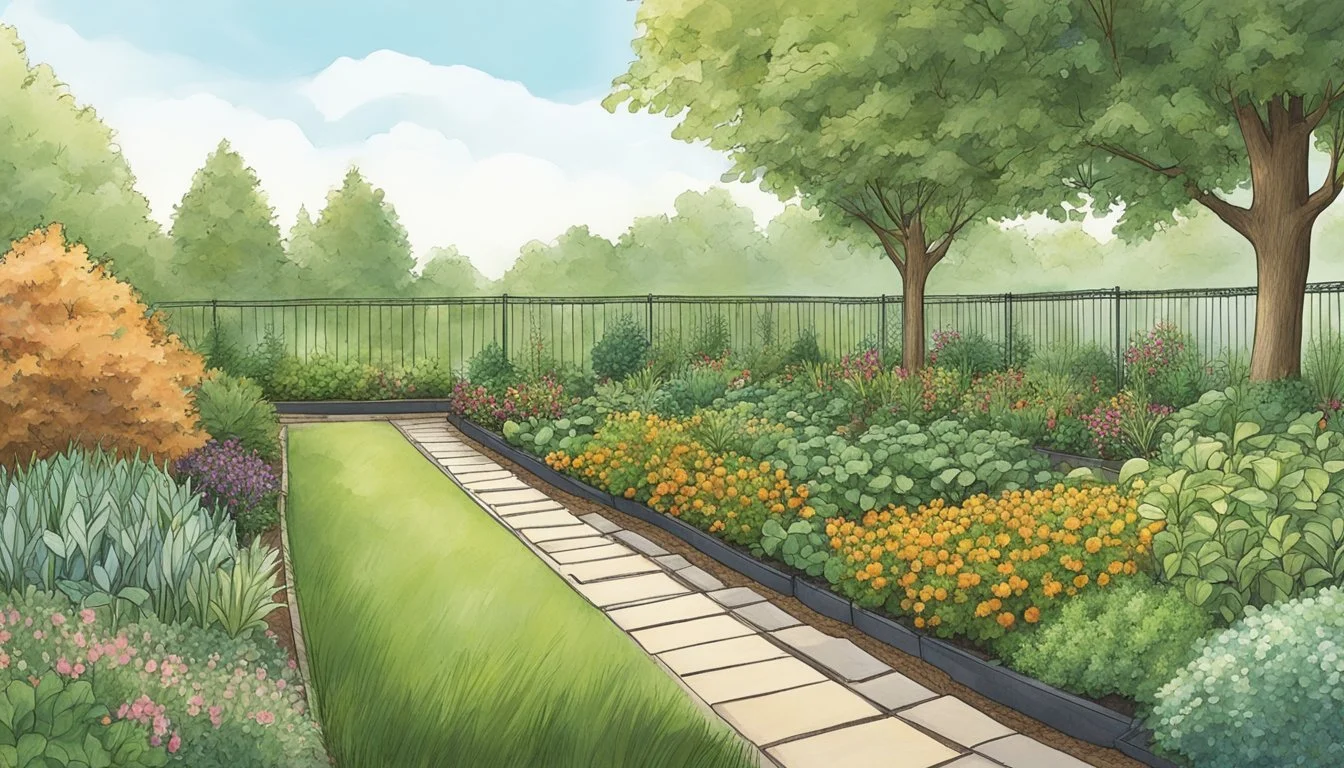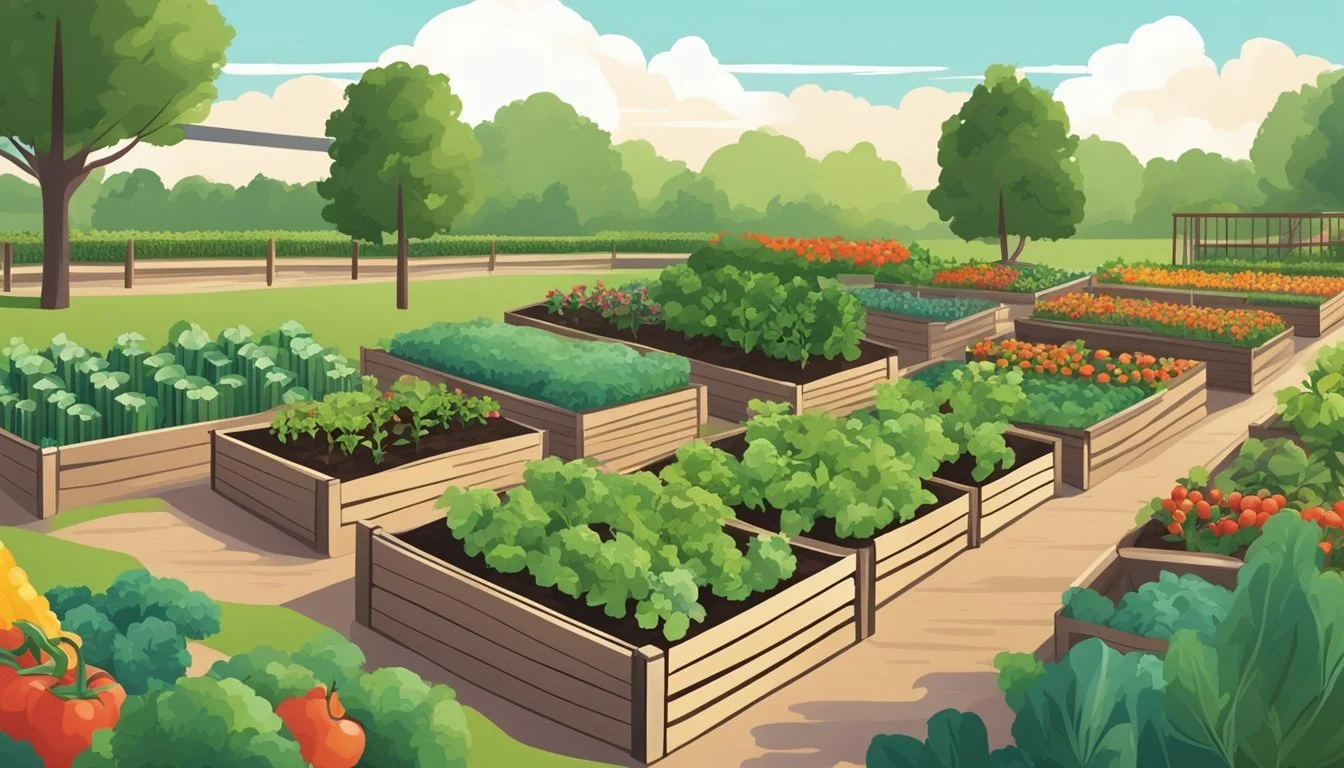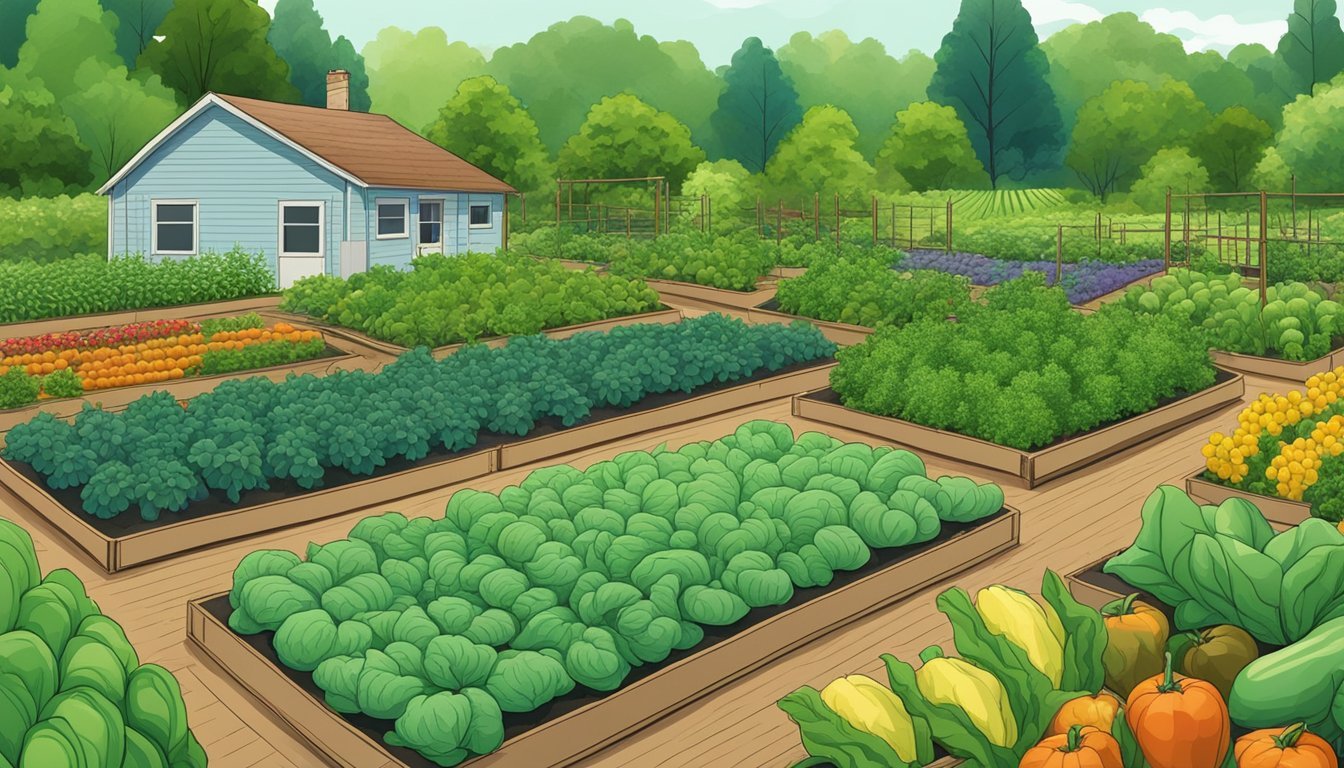Vegetable Gardening in Indiana
A Guide to Thriving Gardens in the Hoosier State
This Article is Part of Our Guide on Vegetable Gardening by State
Vegetable gardening in Indiana offers a unique opportunity for gardeners to take advantage of the region's diverse climate conditions. Situated predominantly in USDA hardiness zones 5 and 6, Indiana presents an environment where a variety of vegetables can flourish. The state experiences four distinct seasons, providing both challenges and opportunities for those looking to cultivate their own produce. Strategic planning is key, as understanding the local frost dates and seasonal weather patterns can greatly influence the success of a garden.
Gardeners in Indiana can start their vegetable gardening endeavors early in the spring, with cold-hardy vegetables such as lettuce, which can endure cooler temperatures and even light frosts. Selecting the right varieties and planning according to the specific zone within the state are critical steps in achieving a bountiful harvest. Summer brings warmer temperatures that are suitable for a wide range of vegetables, while fall gardening can extend the growing season of certain crops that thrive in cooler weather.
Cultivating vegetables in Indiana is not just about planting and harvesting; it's about adapting to the local conditions and understanding the rhythm of the seasons. With the right approach, Indiana can be a productive and rewarding place for both novice and experienced gardeners to grow their own vegetables, whether they are seeking to supplement their diet, enjoy the freshness of home-grown produce, or simply engage with the natural world through gardening.
Planning Your Vegetable Garden
A successful vegetable garden in Indiana starts with meticulous planning and understanding the local climate conditions. One's gardening endeavor can flourish by choosing an optimal location, selecting suitable vegetables, and grasping the region's hardiness zones.
Selecting the Right Location
Achieving a bountiful garden requires attention to the location. Direct sunlight is essential; plants ideally need at least six hours of sun every day. Gardeners should prioritize finding a site with ample sunlight and consider sketching out their garden layout beforehand. The plot also needs well-draining soil to prevent waterlogging, which can damage the roots.
Choosing the Best Vegetables for Indiana
When deciding on which vegetables to grow, it's crucial to choose plants that will thrive in Indiana's climate. Here are some vegetables known to do well:
Lettuce: A cool-weather vegetable that can be planted in both spring and fall.
Tomatoes: Require warm temperatures and well-drained soil.
Green Beans: Tolerant of a variety of soils and conditions.
Peppers: Thrive in the heat and need a long growing season.
Cucumbers: Prefer warm, humid weather and need plenty of space to grow.
Each of these vegetables has specific spacing and depth requirements, so gardeners should consult a detailed planting guide before starting their garden.
Understanding Hardiness Zones
Hardiness zones are crucial when planning a vegetable garden. Indiana spans USDA zones 5 and 6, indicating the temperature ranges plants must withstand to survive. These zones guide the timing of seeding and transplanting. For instance, knowing the dates of the first and last frost allows for accurate scheduling of planting to ensure vegetables can grow without frost damage. Gardeners must become familiar with these zones and adjust their planting schedules accordingly.
Soil Preparation and Management
Proper soil preparation is crucial for a successful vegetable garden in Indiana. The focus should be on testing and amending the soil, as well as properly tilling and establishing an efficient garden layout.
Soil Testing and Amendment
Before planting, one should test the soil to determine its pH level and nutrient profile. Soil may require amendments to enhance its fertility and structure. For instance, incorporating 2-3 inches of compost, peat moss, or well-decomposed manure can significantly improve soil richness and drainage. Fertilizers should be added according to the specific needs identified in the soil test, tailored to support the vegetables planned for the garden.
Tilling and Garden Layout
Tilling the soil to a depth of at least 6 inches is recommended to enable good root growth. Using a rototill simplifies this process, especially for larger areas. For smaller plots, manual tilling with a spade is adequate. The layout should allow for easy access and maintenance, considering factors like sunlight exposure and soil temperature. Rows or beds should be level, with paths in between to prevent compaction, thereby maintaining good drainage throughout the garden.
Planting Techniques
Choosing the right planting techniques is essential for a successful vegetable garden in Indiana. Proper methods maximize germination rates and promote healthy seedling development, critical for a bountiful harvest.
Starting Seeds Indoors
Seedlings benefit from a controlled environment before facing the unpredictable Indiana weather. Starting seeds indoors should occur 6-8 weeks before the last frost date. Gardeners use seed-starting mix in trays or pots, ensuring consistent moisture and warmth. A common setup includes:
Seed trays: Fill with sterile seed-starting mix.
Heat mats: Place beneath trays to promote germination (68°F - 70°F is ideal).
Grow lights: Ensure seedlings receive at least 14-16 hours of light per day.
Label each tray with the plant’s name and the date sown to keep track of progress and planting times.
Direct Sowing
Direct sowing involves planting seeds (how long do seeds last?) directly into garden soil. This method is best for plants that do not transplant well or those that grow quickly, such as radishes and carrots. To direct sow:
Prepare the garden bed: Remove weeds, loosen soil, and ensure good drainage.
Plant at proper depth: Refer to seed packet for specific guidelines.
Spacing: Seeds should be sown at intervals to reduce the need for thinning.
Watering should be gentle to prevent seeds from washing away. Mulching may be applied to conserve moisture and regulate soil temperature.
Transplanting Seedlings
Transplants offer a head start on the growing season. After the last frost date, it’s time to move seedlings outdoors. Acclimate seedlings by gradually exposing them to the outside environment, a process called hardening off. Transplanting steps include:
Dig holes: Slightly larger than the root ball of the seedling.
Water: Before and after transplanting to ease shock.
Spacing: Follow recommended distances to enable sufficient sun exposure and air circulation.
Fertilizers can be applied according to the specific needs of the plant, but one should always take care not to over-fertilize young plants.
Vegetable Plant Care
Proper watering and fertilization are critical for healthy vegetable growth in Indiana, alongside diligent pest and disease management to ensure a bountiful harvest.
Watering and Fertilizing
Vegetables require regular watering, especially during dry spells. An efficient method is to provide one inch of water per week, whether through rainfall or irrigation. Soil moisture consistency is ideal; avoid overwatering which can lead to root rot and under-watering which can stress plants. Fertilizer use should complement the natural fertility of Indiana soils, usually enriched with organic matter like compost. A balanced N-P-K (nitrogen-phosphorus-potassium) fertilizer supports overall plant health, while additional nitrogen might be necessary for leafy greens like lettuce.
Ideal Watering Practices:
Consistency: Keep soil evenly moist, not soggy.
Method: Drip irrigation or soaker hoses to reduce leaf wetness and disease risk.
Amount: Approximately 1 inch of water per week.
Timing: Early morning watering to reduce evaporation and fungal diseases.
Fertilizer Guidelines:
Initial Soil Test: To determine existing nutrients and pH level.
Organic Matter: Compost or well-rotted manure to improve soil health.
N-P-K Ratio: Use as per soil test recommendations.
Application: Follow label instructions, avoid overuse which can damage plants and pollute waterways.
Pest and Disease Management
Pest and disease management begins with selecting resistant vegetable varieties and practicing good garden hygiene. Regular monitoring for insects like aphids, beetles, and caterpillars helps gardeners act swiftly to control infestations. Physical barriers, such as row covers, can prevent pests, while organic options like neem oil or insecticidal soaps serve as treatment. Disease prevention relies on crop rotation, proper spacing for air circulation, and avoiding water splash on foliage. Weeds should be controlled as they can harbor pests and compete for nutrients and water.
Pest Control Tactics:
Prevention: Choose resistant varieties and use row covers.
Monitoring: Check plants regularly for early signs of insect activity.
Mechanical Controls: Hand-picking pests off plants.
Biological Controls: Encourage beneficial insects that prey on pests.
Disease Prevention Measures:
Crop Rotation: Change planting locations annually to disrupt disease cycles.
Spacing: Allow for air flow to reduce fungal disease spread.
Watering: Direct water to the soil, not plant leaves, to lower disease risk.
Weed Management: Regular removal of weeds to prevent pest habitat and disease spread.
Select Vegetables and Their Cultivation
In Indiana, successful vegetable gardening involves understanding the regional climate and the specific needs of each vegetable type. This section provides guidance on cultivating select vegetables that flourish in Indiana's varied seasons.
Growing Leafy Greens
Leafy greens like lettuce, spinach, and kale prefer cooler weather, making them ideal for spring or fall planting in Indiana. They thrive in well-drained soil enriched with organic matter. Lettuce prefers partial shade, which can help prevent it from bolting too quickly during warm spells. Spinach and kale, on the other hand, can tolerate full sun as long as they receive adequate moisture.
Root Vegetables
Root vegetables, including carrots, radishes, and turnips, are well-suited for Indiana's soil, which should be loose and deep to allow for proper root development. Carrots require a longer growing period and should be sown directly into the ground, while radishes and turnips have shorter growing seasons and can be planted in both spring and fall.
Vegetable Planting Depth Germination Time Harvest Time Carrot 1/4 inch 14-21 days 70-80 days Radish 1/2 inch 5-10 days 22-30 days Turnip 1/2 inch 5-10 days 30-55 days
Fruiting Vegetables
Fruiting vegetables such as tomatoes, peppers, cucumbers, and zucchini prefer warm soil and plenty of sunlight. In Indiana, they should be started indoors 6 to 8 weeks before the last frost date and transplanted outside once the danger of frost has passed. Regular watering and staking or caging for support are essential to maintain healthy growth and fruit production.
Legumes
Legumes like beans, peas, and green beans add nitrogen to the soil, making them a beneficial addition to any garden. They should be planted after the last frost when the soil has warmed. Beans and peas require support for climbing, and they enjoy well-drained soil and full sun exposure. Regular harvesting is key to encouraging continued production throughout the growing season.
Maximizing Garden Efficiency
In Indiana, where garden space might be limited and gardeners aim for maximum yield, applying efficient gardening techniques is crucial. This involves savvy use of vertical spaces and strategic planting schedules.
Vertical Gardening
Vertical gardening is a technique that allows gardeners to grow more crops in a smaller area by utilizing vertical space. It is particularly effective for climbers or sprawling plants, such as pole beans and cucumbers. They recommend:
Trellises: A sturdy trellis provides support for climbers and can be used for beans, peas, and some varieties of squash.
Wall Planters: These can be affixed to fences or walls and are ideal for herbs and lettuce.
Hanging Baskets: Excellent for strawberries and cherry tomatoes, hanging baskets make use of overhead space.
By growing plants vertically, gardeners save space, reduce plant diseases by improving air circulation, and facilitate easier harvesting.
Multicropping and Succession Planting
Multicropping and succession planting are effective methods for extending the harvest and making the most out of the growing season in Indiana.
Multicropping: Planting low-maintenance vegetables together that have different growth rates can lead to a fuller use of space and continuous harvesting. For example, radishes and carrots can be planted in the same row because radishes grow quickly and carrots take longer to mature.
Succession Planting: This involves planting new seeds at intervals. Once one crop is harvested, they can plant a new one in its place. For instance, after harvesting spring radishes, the same space can be used for planting heat-tolerant vegetables like eggplants or peppers.
By adopting these practices, they ensure that garden space is not wasted throughout the season, leading to a more productive vegetable garden.
Harvesting and Storing Crops
In Indiana, vegetable gardening requires timely harvesting and adequate storage methods to ensure crops maintain their quality throughout the year.
Picking at Peak Time
Timing is crucial for harvesting vegetables. The gardener must pick most crops at their ideal maturity stage—neither too early nor too late. For example, some vegetables like lettuce are harvested when they've reached the desired leaf size, while others, such as tomatoes, are best left on the plant until they're fully colored and firm. Many crops can be harvested all year with proper planning and succession planting. This keeps the garden productive and the table stocked with fresh produce across seasons.
Proper Storage Techniques
Once harvested, correct storage extends the shelf life and quality of vegetables. Cool and humid conditions are generally ideal, but the specifics can vary between crops. Here's a guide for different vegetables:
Root vegetables (e.g., carrots, beets): Store in cool, humid conditions, often in boxes of damp sand to prevent drying out.
Leafy greens: Refrigerate in perforated plastic bags to maintain moisture and slow decay.
Squash: Keep in a cool, dry location; warmer and drier than root vegetables, but protect from freezing.
It's important for gardeners to handle their produce carefully to prevent bruising and to wash all vegetables thoroughly before storage to remove any soil and potential pests.
Extending the Growing Season
In Indiana, the growing season can be significantly extended by using structures to protect plants from cooler temperatures and by selecting varieties that can withstand cold conditions.
Using Greenhouses and Cold Frames
Greenhouses offer a controlled environment that can extend the growing season by insulating crops from the chill. They allow gardeners to start seedlings early and grow plants beyond the outdoor growing season by providing warmth and protection from frost. On the other hand, cold frames, which are typically a more affordable and simpler alternative to greenhouses, offer similar benefits. They are essentially miniature greenhouses that can shield plants from the extreme cold, effectively extending the planting season by several weeks.
Key benefits of greenhouses and cold frames:
Protection from frost
Extended transplant season
Warmer microclimate for temperature-sensitive crops
Choosing Cold Hardy Vegetables
Gardeners can extend the growing season by selecting vegetables known for their cold hardiness. Certain vegetables can resist frost and thrive in cooler temperatures, making them ideal for early planting or late harvest.
Here is a list of cold hardy vegetables that can be successfully grown in Indiana:
Brussels sprouts: Able to withstand frost and in fact become sweeter with a touch of frost.
Spinach: Thrives in cooler temperatures and can continue to grow even after a frost.
Radishes: Resistant to frost and have a very short growing cycle.
Lettuce: Certain varieties can survive light frosts and are suitable for late-season planting.
By integrating greenhouses or cold frames into their gardening strategies and choosing appropriate vegetable varieties, gardeners in Indiana can enjoy an extended period of harvest, maximizing their garden's productivity.
Gardening Resources and References
When starting or maintaining a vegetable garden in Indiana, gardeners have access to a variety of valuable resources. These include local garden centers and seed catalogs known for their tailored selections, and authoritative guides from Purdue Extension which provide region-specific advice.
Local Garden Centers and Seed Catalogs
Local garden centers in Indiana offer gardeners a variety of plants, seeds, and gardening products. These centers often provide seeds and plants that are suitable for the local climate and soil conditions. Farm stores also cater to gardeners by stocking tools and supplies needed for establishing and nurturing a vegetable garden.
Local Garden Centers: These should be a gardener's first stop for regional advice and the best plant varieties for the Indiana climate.
Farm Stores: They often provide both supplies and expert local advice.
Seed Catalogs: Gardeners can browse an extensive range of vegetable seeds that are appropriate for planting in Indiana's unique growing conditions.
Disclaimer: When using products recommended by garden centers or catalogs, gardeners should follow the current directions and heed any warnings provided by the manufacturer.
Purdue Extension Publications
Purdue Extension offers a wealth of publications tailored to gardening in Indiana. These resources are instrumental for gardeners who wish to improve their horticultural knowledge and get specific planting guidance.
Publications: Focused on a wide array of topics, including soil preparation, planting times, and plant care.
Fertilization and Care Guides: The extensions provide scientifically backed information on how to properly nourish and maintain vegetable gardens.
Garden Planning: Publications also cover how to plan and design a functional garden space.
Purdue Extension's resources serve as a credible reference point for gardeners. Through its publications, Purdue Extension often disclaims endorsement of products in favor of providing unbiased, research-backed information. They stress the responsibility of the gardener to use products according to the manufacturer's specifications and similar uses.
Starting Your Garden Checklist
Before one begins their gardening journey in Indiana, it's imperative to gather the essential tools and supplies and outline a garden planning timeline to ensure a fruitful harvest.
Tools and Supplies
Essential Tools:
Spade: Necessary for turning the soil.
Rototiller (optional): Ideal for preparing larger garden beds.
Drip irrigation system: This water-conserving option provides steady moisture directly to the plant roots and reduces the prevalence of weeds.
Garden Care Supplies:
Watering tools: Whether a hose with a spray nozzle or watering cans, consistent watering is crucial to success.
Weed control: Options range from mulch to environmentally friendly weeding tools.
Chemicals: Use of pesticides or herbicides should be cautious and follow label instructions for safe vegetable gardening.
Garden Planning Timeline
Initial Steps:
Select the right location: Ensure the spot gets at least six hours of direct sunlight per day.
Sketch the garden layout: Planning where each vegetable will go helps maximize the use of space and sunlight.
Planting Schedule:
Month Action Items Late winter Start seeds indoors for transplant Early spring Prepare beds as soon as soil is workable Mid-spring Plant cold-tolerant vegetables After last frost Plant warm-weather crops
By diligently following these steps, gardeners can create an efficient plan for their vegetable garden, with a focus on timing and tools that encourage a thriving garden free from excessive weeds and diseases.
Conclusion
Vegetable gardening in Indiana can be a highly productive endeavor due to the state's favorable growing conditions. Gardeners can achieve success by selecting the appropriate plants for the climate and adhering to the state's planting schedules. For example, lettuce, onions, and broccoli thrive in the cool temperatures of Indiana's springs, especially in Zone 6.
Proper plant care, such as adequate sunlight, water, and pest management, is critical for a healthy garden. Residents are advised to plant only the vegetables their families enjoy, while also considering experimenting with new varieties. Vegetables like tomatoes and peppers have numerous cultivars that could add diversity and resilience to one's garden.
The benefits of growing a vegetable garden in Indiana are manifold. They provide fresh produce, enhance food security, and offer the satisfaction of tending to a living ecosystem. Gardeners should always look for up-to-date guidance from local resources to enhance their gardening practices and yield bountiful harvests.
Seasonal Advice Plant Suggestions Care Tips Spring Planting Lettuce, Onions, Broccoli Monitor for slugs, ensure adequate moisture Summer Care Heat-tolerant varieties Water efficiently, provide shade if necessary Fall Preparation Short season produce Prepare for cool weather, protect from frost
With a concerted effort and a willingness to learn, residents can turn their gardening ventures into a rewarding component of their lifestyle.










